

Social and emotional wellbeing: development of a children's headline indicator. A child's social and emotional wellbeing is integral to their overall health, development and wellbeing.
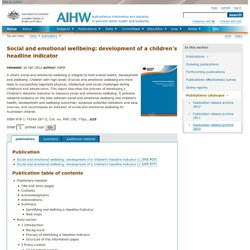
Children with high levels of social and emotional wellbeing are more likely to successfully negotiate physical, intellectual and social challenges during childhood and adolescence. This report describes the process of developing a Children's Headline Indicator to measure social and emotional wellbeing. It presents research evidence on the links between social and emotional wellbeing and children's health, development and wellbeing outcomes; assesses potential indicators and data sources; and recommends an indicator of social and emotional wellbeing for Australian children. ISBN 978-1-74249-287-2; Cat. no. PHE 158; 77pp Publication Publication table of contents Recommended citation.
Tips for Teaching Mindfulness to Kids. How can we build the quality of mindfulness in our children, our classrooms, and our schools?
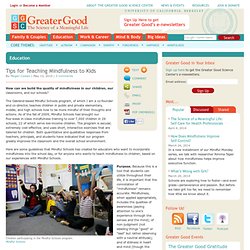
The Oakland-based Mindful Schools program, of which I am a co-founder and co-director, teaches children in public and private elementary, middle, and high schools how to be more mindful of their thoughts and actions. As of the fall of 2009, Mindful Schools had brought our five-week in-class mindfulness training to over 7,000 children in 26 schools, 22 of which serve low-income children. The program is secular, extremely cost-effective, and uses short, interactive exercises that are tailored for children.
Both quantitative and qualitative responses from teachers, principals, and students have indicated that our program greatly improves the classroom and the overall school environment. Dr. Shanker and Self Regulation – Continuing the Conversation. February 19, 2013 by cultureofyes Two of my most popular posts have been about Dr.
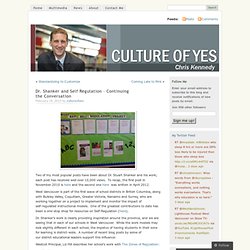
Stuart Shanker and his work; each post has received well over 10,000 views. To recap, the first post in November 2010 is here and the second one here was written in April 2012. West Vancouver is part of the first wave of school districts in British Columbia, along with Bulkley Valley, Coquitlam, Greater Victoria, Nanaimo and Surrey, who are working together on a project to implement and monitor the impact of self-regulated instructional models. One of the greatest contributions to date has been a one-stop shop for resources on Self-Regulation (here).
Dr. Westcot Principal, Liz Hill describes her school’s work with The Zones of Regulation: We often make the assumption that children know how to identify their emotions, but akin to teaching reading, writing and math, emotional literacy is a skill that needs to be taught to our children. Like this: Like Loading... The Importance of Teaching Mindfulness. Flickr: ssoosay By Aran Levasseur Think of sitting quietly in a spartan room. There are no TVs, computers, smartphones, books, magazines or music. If you’re like most people, this probably sounds like a recipe for boredom. In our culture, we avoid moments of “not-doing” because we don’t associate boredom with having any value. It’s been said that the currency of the Net is attention. A torrent of stimulation is just a click or touchscreen away, ensuring that even the slightest trace of boredom can be mitigated through constant screen connectivity. Recent brain imaging studies reveal that sections of our brains are highly active during down time.
“Downtime is to the brain what sleep is to the body.” Earlychildhood NEWS - Article Reading Center. Ask the Expert: Calming the Anxious Child By Ronnie Ginsberg, Psy.D.
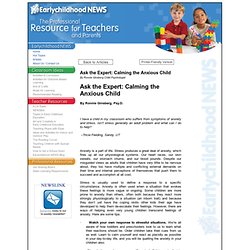
I have a child in my classroom who suffers from symptoms of anxiety and stress. Isn’t stress generally an adult problem and what can I do to help? –Tricia Fielding, Sandy, UT Anxiety is a part of life. Stress is usually used to define a response to a specific circumstance. . · Watch your own response to stressful situations. . · Give choices and encourage self-control. . · Establish predictable routines. . · Use anticipation to help quell anxiety. . · Encourage competence. . · Teach relaxation techniques. . · Keep expectations realistic.
. · Watch out for the symptoms of stress and anxiety. MindfulnessNow - mindfulness psychology counselling for adults, children and adolescents in Perth Western Australia. On this page we would like to share our own news with you, together with the latest developments in mindfulness, particularly here in Australia.
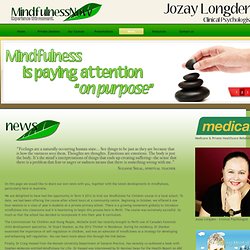
We are delighted to have had the opportunity in Term 4 2012 to trial our Mindfulness for Children course in a local school. To date, we had been offering the course after-school hours at a community centre. Beginning in October, we offered 6 one hour sessions to a class of year 6 students at a private primary school. There is a growing movement globally to introduce mindfulness into classrooms and it is heartening to begin this process here in Perth. The course was extremely succesful. The Commissioner for Children and Young People, Michelle Scott has recently brought to Perth one of Canada's foremost child development specialists, Dr Stuart Shanker, as the 2012 Thinker in Residence.
For additional material, please see our resource section, or take a look at the mindfulness courses on hand we will be offering. Latest Mindfulness News.